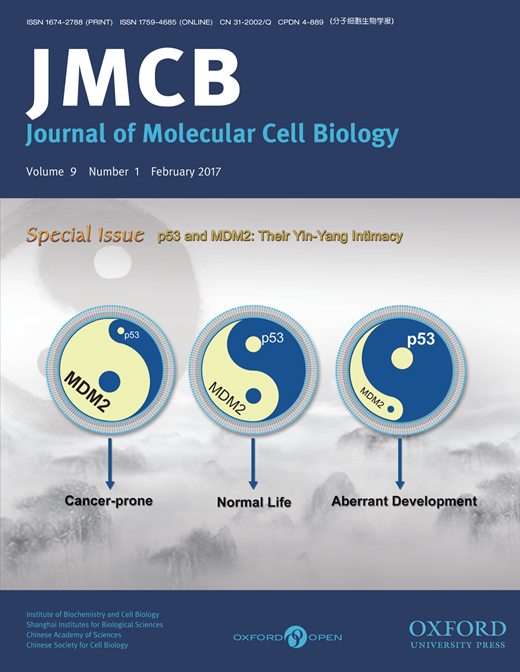p53 and MDM2: their Yin-Yang intimacy
|
Mdm2 as a chromatin modifier
Magdalena Wienken, Ute M. Moll, and Matthias DobbelsteinJ Mol Cell Biol, Volume 9, Issue 1, February 2017, 74-80, https://doi.org/10.1093/jmcb/mjw046Abstract | Full Text |
Modulation of the p53/MDM2 interplay by HAUSP inhibitors
|
Role of Mdm2 and Mdmx in DNA repair
Christine M. EischenJ Mol Cell Biol, Volume 9, Issue 1, February 2017, 69-73, https://doi.org/10.1093/jmcb/mjw052Abstract | Full Text |
Negative auto-regulators trap p53 in their web
|
Anatomy of Mdm2 and Mdm4 in evolution
Ban Xiong Tan, Hoe Peng Liew, Joy S. Chua, Farid J. Ghadessy, Yaw Sing Tan, David P. Lane, and Cynthia R. CoffillJ Mol Cell Biol, Volume 9, Issue 1, February 2017, 3-15, https://doi.org/:10.1093/jmcb/mjx002Abstract | Full Text |
Mdm proteins: critical regulators of embryogenesis and homoeostasis
Sydney M. Moyer, Connie A. Larsson, and Guillermina LozanoJ Mol Cell Biol, Volume 9, Issue 1, February 2017, 16-25, https://doi.org/10.1093/jmcb/mjx004Abstract | Full Text |
Regulation of kidney development by the Mdm2/Mdm4–p53 axis
Samir El-Dahr, Sylvia Hilliard, and Zubaida SaifudeenJ Mol Cell Biol, Volume 9, Issue 1, February 2017, 26-33, https://doi.org/10.1093/jmcb/mjx005Abstract | Full Text |
Mouse modelling of the MDM2/MDMX−p53 signalling axis
Nicole R. Tackmann, and Yanping ZhangJ Mol Cell Biol, Volume 9, Issue 1, February 2017, 34-44, https://doi.org/10.1093/jmcb/mjx006Abstract | Full Text |
The role of MDM2 and MDM4 in breast cancer development and prevention
Sue Haupt, Reshma Vijayakumaran, Panimaya Jeffreena Miranda, Andrew Burgess,Elgene Lim, and Ygal HauptJ Mol Cell Biol, Volume 9, Issue 1, February 2017, 53-61, https://doi.org/10.1093/jmcb/mjx007Abstract | Full Text |
